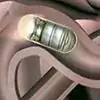Rifabutin
Rifabutin: instructions for use and reviews
- 1. Release form and composition
- 2. Pharmacological properties
- 3. Indications for use
- 4. Contraindications
- 5. Method of application and dosage
- 6. Side effects
- 7. Overdose
- 8. Special instructions
- 9. Application during pregnancy and lactation
- 10. Use in childhood
- 11. In case of impaired renal function
- 12. For violations of liver function
- 13. Use in the elderly
- 14. Drug interactions
- 15. Analogs
- 16. Terms and conditions of storage
- 17. Terms of dispensing from pharmacies
- 18. Reviews
- 19. Price in pharmacies
Latin name: Rifabutin
ATX code: J04AB04
Active ingredient: rifabutin (Rifabutin)
Manufacturer: JSC "Moskhimfarmpreparaty im. N. A. Semashko "(Russia); Valenta Pharmaceuticals (Russia); Ozone LLC (Russia); Lupine, Ltd. (Lupin, Ltd.) (India); Lock-Beta Pharmaceuticals (I) Pvt. Ltd. [Lok-Beta Pharmaceuticals (I) Pvt. Ltd.] (India)
Description and photo updated: 30.11.2018

Rifabutin is an anti-tuberculosis drug, an antibiotic of the rifampicin group.
Release form and composition
The drug is available in the form of capsules: size No. 0, hard gelatinous, body and cap, depending on the manufacturer, from bright red to red-brown; the contents of the capsules are powder from dark purple to purple-brown color, the presence of lighter inclusions is not excluded (in a blister strip / blister 5 or 10 pcs., in a cardboard box 1-10 packages / blisters and instructions for the use of Rifabutin; in a polymer container of 10, 20, 30, 40, 50, 60 or 100 pcs., in a carton pack 1 container; other types of packaging are possible, including those intended for hospitals).
Composition of 1 capsule:
- active ingredient: rifabutin - 150 mg;
- additional substances: medical low molecular weight polyvinylpyrrolidone (povidone), magnesium stearate, pregelatinized starch, sodium lauryl sulfate, aerosil (colloidal silicon dioxide), talc, gelatin, azorubin (acid red 2C), proprietary blue, brilliant black 4, quin.
Depending on the manufacturer, a different composition of the capsule auxiliary components is possible.
Pharmacological properties
Pharmacodynamics
Rifabutin is a semi-synthetic antibiotic with a broad spectrum of antibacterial action. Shows effectiveness against microorganisms located intra- and extracellularly. Selectively inhibits DNA-dependent RNA polymerase of sensitive bacteria. Shows high activity against Mycobacterium spp. (M. tuberculosis, M. avium intracellulare complex and other atypical mycobacteria). Between 33 and 50% of rifampicin-resistant M. tuberculosis strains are susceptible to rifabutin, suggesting incomplete cross-resistance between these antibiotics. The drug is active against many gram-positive microorganisms.
The drug is recommended for use in combination treatment with other antibacterial drugs, since rifabutin monotherapy leads to the rapid development of resistance.
Pharmacokinetics
Rifabutin is rapidly absorbed in the gastrointestinal tract. Eating fatty foods does not affect the rate of absorption, but decreases its rate.
Bioavailability is 20%. The time to reach the maximum concentration of a substance in plasma (C max) is from 2 to 4 hours. Plasma protein binding - 85%. Plasma levels are maintained above the minimum inhibitory concentration for M. tuberculosis up to 30 hours after ingestion.
The pharmacokinetics of rifabutin at a single dose of 300, 450 or 600 mg is linear, with the C max value being determined in the range from 0.4 to 0.7 μg / ml. It penetrates well into the cells of various organs and tissues. The ratio of the intracellular concentration to the extracellular concentration is 9 for neutrophils and 15 for monocytes.
The substance permeates through the blood-brain barrier (rifabutin levels in the cerebrospinal fluid is approximately 1 / 2 from the plasma). The highest concentration is observed in the lungs (a day after administration, it is 5-10 times higher than the plasma concentration).
The volume of distribution (V d) is 9 l / kg.
It is metabolized in the liver to form inactive metabolites.
It is excreted in the form of metabolites: with urine - 53%, with bile - 30%. The half-life (T 1/2) is 35 to 40 hours.
Indications for use
- chronic multidrug-resistant pulmonary tuberculosis caused by rifampicin-resistant M. tuberculosis strains - as part of combination therapy;
- infections (localized / disseminated) caused by M. tuberculosis, M. avium intracellulare complex, M. xenopi and other atypical bacteria, including in patients with immunodeficiency, in whom the number of CD4 lymphocytes is 200 / μl and below - in the combined therapy;
- infections (localized / disseminated) caused by M. tuberculosis, M. avium intracellulare complex, M. xenopi and other atypical bacteria, including in immunocompromised patients with a CD4 lymphocyte count of ≤ 200 / μl - prophylaxis, monotherapy.
Contraindications
Absolute:
- period of pregnancy;
- breast-feeding;
- hypersensitivity to rifampicins (including rifabutin), including a history.
Relative (caution should be exercised when using Rifabutin capsules):
- severe renal failure;
- severe hepatic failure.
Some manufacturers indicate in the instructions for use of the drug that it is contraindicated in children and adolescents under 18 years of age, due to the lack of data on the safety and effectiveness of therapy in this age group of patients.
Rifabutin, instructions for use: method and dosage
Take Rifabutin capsules inside, 1 time per day, regardless of food intake.
Recommended dosage:
- chronic multidrug-resistant pulmonary tuberculosis: 300-450 mg per day; duration of therapy - up to six months from the time a negative culture was obtained;
- pulmonary tuberculosis (newly diagnosed): 150–300 mg per day; duration of therapy - up to six months;
- non-tuberculous mycobacterial infection (in combination with other drugs): 450–600 mg per day; duration of therapy - up to six months from the time a negative culture was obtained;
- infections in patients with immunosuppression (prophylaxis): 300 mg per day.
For patients with creatinine clearance (CC) less than 30 ml / min, the dose of the drug is halved.
In the case of moderate impairment of renal / hepatic function, dose adjustment is not necessary.
Side effects
- musculoskeletal system: myalgia, arthralgia;
- gastrointestinal tract: nausea, vomiting, diarrhea, dysgeusia (change in taste), abdominal pain, jaundice, increased activity of hepatic transaminases;
- allergic reactions: rash, fever, in rare cases - bronchospasm, uveitis, eosinophilia, anaphylactic shock;
- laboratory parameters: anemia, thrombocytopenia, leukopenia.
Overdose
Due to an overdose of rifabutin, an increase in negative side reactions is possible.
If you suspect taking high doses of the drug, gastric lavage is performed and diuretics are prescribed. In the future, it is possible to use symptomatic therapy.
special instructions
During therapy with rifabutin, the number of platelets and leukocytes in the peripheral blood, as well as the activity of liver enzymes, should be systematically monitored.
The risk of developing uveitis is higher in the case of its combined use with clarithromycin, or when taking high doses of the drug. If combination therapy is warranted, the daily dose of Rifabutin is reduced to 300 mg. Patients taking rifabutin in conjunction with clarithromycin or other macrolides and / or with fluconazole and similar compounds should be monitored by a doctor. When diagnosing uveitis, it is necessary to consult an ophthalmologist and temporarily stop taking Rifabutin.
The drug is capable of imparting a reddish orange color to urine, skin and secreted fluids. In this regard, it is not recommended for patients taking the drug to wear contact lenses due to the possibility of their coloring in orange.
Used as monotherapy for the prevention of M. avium-induced disease in tuberculosis patients, rifabutin can lead to the development of cross-resistance to rifampicin and rifabutin. Therefore, it is advisable to take it in combination with anti-tuberculosis drugs that do not belong to the rifampicin group.
Women of reproductive age should use barrier contraception because oral contraceptives may not work.
Influence on the ability to drive vehicles and complex mechanisms
The effect of the drug on the ability to drive vehicles and complex mechanisms has not been established.
Application during pregnancy and lactation
During gestation and breastfeeding, the drug is contraindicated.
Pediatric use
There is no data on the use of Rifabutin in children and adolescents under 18 years of age.
With impaired renal function
In severe renal failure, the drug should be taken with caution.
In patients with moderate impairment of renal function, dose adjustment is not necessary.
For violations of liver function
In severe hepatic impairment, the drug should be taken with caution.
In patients with moderate impairment of hepatic function, dose adjustment is not necessary.
Use in the elderly
There are no special recommendations for taking Rifabutin to elderly patients.
Drug interactions
- enzymes of the cytochrome P 450 family (in particular CYP3A): rifabutin induces them, thereby influencing the pharmacokinetics of drugs metabolized by these enzymes, which, if necessary, combined administration may require an increase in the dose of the latter;
- oral contraceptives: their effectiveness decreases (it is recommended to use other means of contraception);
- didanosine, isoniazid, ethambutol: no interaction detected;
- theophylline, sulfonamides, pyrazinamide, fluconazole, zalcitabine: drug interactions are unlikely, but fluconazole may increase plasma rifabutin levels;
- zidovudine: its plasma concentration decreases;
- clarithromycin: there may be an increase in the plasma level of rifabutin (the daily dose of the drug in this case should not exceed 300 mg);
- isoniazid, pyrazinamide and especially prothionamide: their antimicrobial activity is significantly increased.
Analogs
Rifabutin analogs are Verbutin, Mycobutin-Ross, Mycobutin, Rifabutin-Ferein, Rifampicin, Kansamin, etc.
Terms and conditions of storage
Store in compliance with temperature conditions: T ≤ 25 ° C. Protect from light and moisture.
Keep out of the reach of children.
The shelf life is 2 or 3 years (depending on the manufacturer).
Terms of dispensing from pharmacies
Dispensed by prescription.
Reviews about Rifabutin
Patients leave mostly positive reviews about Rifabutin. They note the strong effect of the antibiotic and its effectiveness in cases where other antibacterial agents were powerless. It is indicated that the drug acts in combination with other anti-tuberculosis drugs better than with monotherapy. It has a milder effect on the body and causes fewer side effects compared to analogues.
At the same time, patients are warned that when taking Rifabutin, body fluids, including tears, turn orange or bright red. In this connection, it is not recommended to wear contact lenses during drug therapy.
Experts say that this anti-tuberculosis drug, when taken for a long time, does not cause the development of tolerance, therefore it can be prescribed for a sufficiently long period. Although there are no established time requirements for taking it, the antibiotic is advised to be taken after meals to reduce the risk of adverse gastrointestinal effects. Additionally, a course intake of hepatoprotectors is recommended.
Among the disadvantages of the drug indicate the development of such adverse reactions as slight drowsiness and nausea, manifested in a mild form. An additional inconvenience is the effect of rifabutin on the action of oral contraceptives, which, when taken together, reduce their effectiveness.
The price of Rifabutin in pharmacies
The price of Rifabutin is 2,400-2,600 rubles. per pack of 30 capsules.

Maria Kulkes Medical journalist About the author
Education: First Moscow State Medical University named after I. M. Sechenov, specialty "General Medicine".
Information about the drug is generalized, provided for informational purposes only and does not replace the official instructions. Self-medication is hazardous to health!







